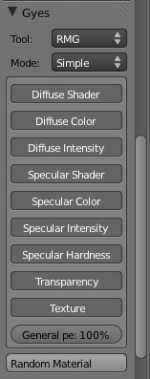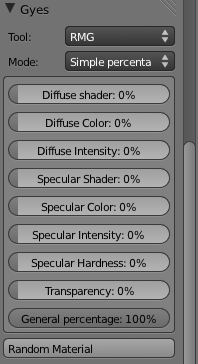「Extensions:2.6/Py/Scripts/System/Gyes/RMG」の版間の差分
("Enanle" => "Enable") |
(相違点なし)
|
2012年1月11日 (水) 20:49時点における版
目次
Links : Gyes , RTG , History Tool
What is RMG ?
RMG or Random Material Generator, is a tool that generates random material, that can assign to one or multiple objects
Why would I need a random material ?
Randomization wont be necessary in case you aim for a specific material and know exactly how to achieve it.
RMG/RTG is useful for the following 3 cases:
- you dont want a specific material/texture just searching around for something really original and surprising
- you want something specific but cant figure out how exactly to achieve and find yourself testing various parameter settings all the time. (this addon is an excellent learning tool)
- you aim for specific material/texture , know how to achieve it , but you would like to try some diffirent variations of it just for fun and curiosity.
In the above 3 cases RMG and RTG can speed up your workflow 10 even 100 times .
Of course installing and giving it a try shouldnt take you more than 10 minutes , randomisation itself takes only a fraction of a second . You can then decide if it fits to your workflow or not.
Enable Mode
Enable mode contains material parameters that can be enabled and disabled for randomization. RMG allows to set which parameters are randomized and which are not. This is needed when there is already a material created and edited and you don't want to randomize all parameters. There are the following parameters.
- Diffuse Shader - Enable / Disable Diffuse Shader parameters for randomisation.
- Diffuse Color - Enable / Disable Diffuse Color for randomisation.
- Diffuse Intensity - Enable / Disable Diffuse Intensity for randomisation.
- Specular Shader - Enable / Disable Specular Shader parameters for randomisation.
- Specular Color - Enable / Disable Specular Color for randomisation.
- Specular Intensity - Enable / Disable Specular Intensity for randomisation.
- Specular Hardness - Enable / Disable Specular Hardness for randomisation.
- Transparency - Enable / Disable Specular Transparency for randomisation. When you enable transparency randomization all random materials generator will be transparent , when transparency randomization is disabled all generated random material are opaque. All transparency related parameters are randomized
- Texture - Enable / Disable randomisation for textures. This option triggers RTG and it will use all the options of RTG. It provides a shortcut so you don't have to change between RMG and RTG for creating random materials with random textures. See RMG for how to set more option for texture randomization.
- General Percentage - General Percentage , will be explained in detail in the following section "Simple Percentage". In short it control how much random your material is.
- Random Material - Clicking this button will generate the random material, always taking into account the above options.
Random Materials are generated not only for a single object. Multiple objects can be selected too and when you hit the Random Material button, it will generate a unique random material for each one of them. So lets say you selected 1000 objects and you hit Random Material , 1000 random materials will be created, all of them according to the options you have chosen. The process is very fast , but of course depends on the amount of objects chosen.
Simple Percentage Mode
With percentage randomisation you can control how much random your material is . You can randomise existing materials as much as you want. This mode offers the same options as simple mode , but instead of enable/disable buttons , there are sliders that go from 0 - 100% .Those specific percentages will aplly randomisation to specific parameters, all other parameters not covered by the specific percentages are covered by the general percentage. When a specific percentage is zero, the general percentage is used instead for that area. This way you can use general percentage to randomize the same multiple parameters without wasting time setting the same specific percentages for them. When a specific percentage is not zero then general percentage is ignored and specific percentage is used instead. If you dont want to randomise that set of parameters at all, in "simple" page use the corresponding button to completely disable it , the percentage slider will also be disabled in the "percentage" page.
Percentage randomisation means that the parameter is randomised inside a range of percentage of the full range of the value. Randomisation is always 50% of the specific percentage bellow the current value and 50% above . If the percentage exceeds minimum and maximum value of the full range, then it will default to minimum and maximum accordingly.
Example:
For example a 50% randomisation of the specular intensity means the following :
Lets take the hypothetical scenario of 50% randomization of specular intensity. Specular intensity range of possible values start from 0 and end at 1 , 1 being the maximum value , 50% of 1 is 0.5 . If your existing specular intensity value is 0.3 then randomisation will range from 0.05(-25%) to 0.55(+25%) , which mean it can be any value that exists in this range which is a range of 0.5 or 50% of full range. Of course randomisation takes always the current value as starting point so the next randomisation will use the current randomised value as starting point.
| Tip | |
| Percentage Randomization is ideal when you got an existing material you like but you want to experiment abit more with it generating new variations of it. Remember to hit the "+" in the material tab to create an identical material and thus protect the original if you happen to not like the randomization. |
Help Mode
Help mode offers a brief explanation of RMG's functionality . You can use the "Text Width" slider to set the point where text wraps to take full advantage of the available space of the resized panel.
History Tool
History Tool is a shared tool between RMG and RTG it assist with organization of materials and it also provide means to track all changes to your materials and textures. Its full function is explained here

